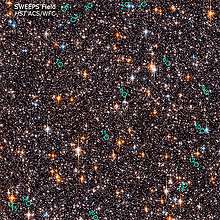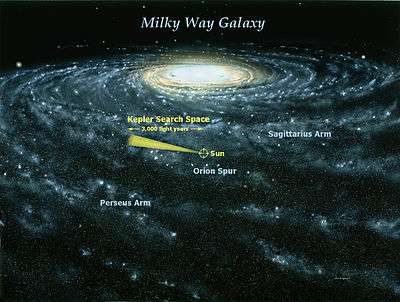Trans-Atlantic Exoplanet Survey
The Trans-atlantic Exoplanet Survey, or TrES, used three 4-inch (10 cm) telescopes located at Lowell Observatory, Palomar Observatory, and Teide Observatory to locate exoplanets. It was made using the network of small, relatively inexpensive telescopes designed to look specifically for planets orbiting bright stars using the transit method. The array used 4-inch Schmidt telescopes having CCD cameras and automated search routines. The survey was created by David Charbonneau of the Center for Astrophysics, Timothy Brown of the National Center for Atmospheric Research, and Edward Dunham of Lowell Observatory.[1]
The TrES survey is no longer operational.
Discoveries
The TrES project discovered a total of five planets in its years of operation. All were discovered using the transit method. Note that the discovery papers do not use the "b" suffix typically used in extrasolar planet designations. While forms with and without the b are used in the literature, the table here uses the designations assigned by the discoverers.
| Star | Constellation | Right ascension |
Declination | App. mag. |
Distance (ly) |
Spectral type |
Planet | Mass (MJ) |
Radius (RJ) |
P (days) |
a (AU) |
e | i (°) |
Discovery year |
|---|---|---|---|---|---|---|---|---|---|---|---|---|---|---|
| GSC 02652-01324[1] | Lyra | 19h 04m 09s | +36° 37′ 57″ | 11.79 | 512 | K0V | TrES-1b | 0.61 | 1.081 | 3.030065 | 0.0393 | 0.135 | 88.2 | 2004 |
| GSC 03549-02811(*)[2] | Draco | 19h 07m 14s | +49° 18′ 59″ | 11.41 | 750 ± 30 | G0V | TrES-2b | 1.199 | 1.272 | 2.47063 | 0.03556 | 0 | 83.62 | 2006 |
| GSC 03089-00929[3] | Hercules | 17h 52m 07s | +37° 32′ 46″ | 12.4 | 1300 | G | TrES-3 | 1.92 | 1.295 | 1.30619 | 0.0226 | ? | 82.15 | 2007 |
| GSC 02620-00648(*)[4] | Hercules | 17h 53m 13s | +37° 12′ 42″ | 11.592 | 1400 | F8 | TrES-4 | 0.919 | 1.799 | 3.553945 | 0.05091 | 0 | 82.86 | 2007 |
| GSC 03949-00967[5] | Cygnus | 20h 20m 53s | +59° 26′ 56″ | 13.718 | 1170 | G | TrES-5 | 1.778 | 1.209 | 1.4822446 | 0.02446 | ? | 84.529 | 2011 |
| Note: (*) indicates that the planet orbits one of the stars in a binary star system. | ||||||||||||||
See also
TrES light curves of the Kepler field are available at the NASA Exoplanet Archive
- List of extrasolar planets
Similar exoplanet discovery projects
- XO Telescope or XO
- HATNet Project or HAT
- SuperWASP or WASP
- Kilodegree Extremely Little Telescope or KELT
- Next-Generation Transit Survey or NGTS
References
- Alonso, Roi; et al. (2004). "TrES-1: The Transiting Planet of a Bright K0V Star". The Astrophysical Journal Letters. 613 (2): L153–L156. arXiv:astro-ph/0408421. Bibcode:2004ApJ...613L.153A. doi:10.1086/425256.
- O'Donovan, Francis T.; et al. (2006). "TrES-2: The First Transiting Planet in the Kepler Field". The Astrophysical Journal Letters. 651 (1): L61–L64. arXiv:astro-ph/0609335. Bibcode:2006ApJ...651L..61O. doi:10.1086/509123.
- O'Donovan, Francis T.; et al. (2007). "TrES-3: A Nearby, Massive, Transiting Hot Jupiter in a 31 Hour Orbit". The Astrophysical Journal Letters. 663 (1): L37–L40. arXiv:0705.2004. Bibcode:2007ApJ...663L..37O. doi:10.1086/519793.
- Mandushev, Georgi; et al. (2007). "TrES-4: A Transiting Hot Jupiter of Very Low Density". The Astrophysical Journal Letters. 667 (2): L195–L198. arXiv:0708.0834. Bibcode:2007ApJ...667L.195M. doi:10.1086/522115.
- Mandushev, Georgi; et al. (2011). "TrES-5: A Massive Jupiter-sized Planet Transiting A Cool G-dwarf". The Astrophysical Journal. 741 (2). 114. arXiv:1108.3572. Bibcode:2011ApJ...741..114M. doi:10.1088/0004-637X/741/2/114.
External links
- http://www.space.com/scienceastronomy/070806_largest_exoplanet.html
- "Network of Small Telescopes Discovers Distant Planet". Lowell Observatory. Archived from the original on 2008-04-15. Retrieved 2008-10-15.

